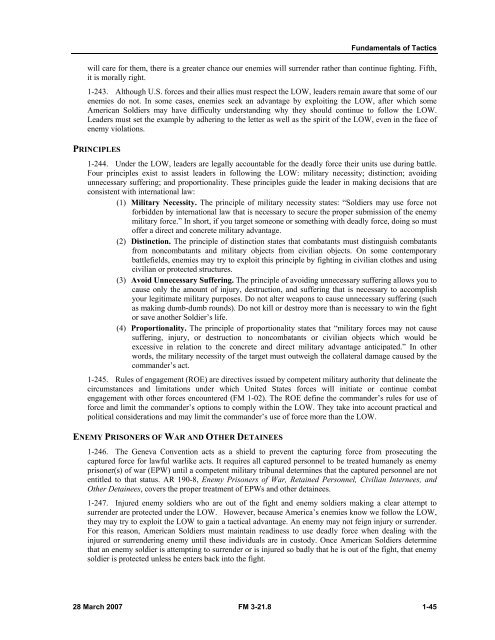Infantry Rifle Platoon and Squad - Sakai
Infantry Rifle Platoon and Squad - Sakai
Infantry Rifle Platoon and Squad - Sakai
You also want an ePaper? Increase the reach of your titles
YUMPU automatically turns print PDFs into web optimized ePapers that Google loves.
Fundamentals of Tactics<br />
will care for them, there is a greater chance our enemies will surrender rather than continue fighting. Fifth,<br />
it is morally right.<br />
1-243. Although U.S. forces <strong>and</strong> their allies must respect the LOW, leaders remain aware that some of our<br />
enemies do not. In some cases, enemies seek an advantage by exploiting the LOW, after which some<br />
American Soldiers may have difficulty underst<strong>and</strong>ing why they should continue to follow the LOW.<br />
Leaders must set the example by adhering to the letter as well as the spirit of the LOW, even in the face of<br />
enemy violations.<br />
PRINCIPLES<br />
1-244. Under the LOW, leaders are legally accountable for the deadly force their units use during battle.<br />
Four principles exist to assist leaders in following the LOW: military necessity; distinction; avoiding<br />
unnecessary suffering; <strong>and</strong> proportionality. These principles guide the leader in making decisions that are<br />
consistent with international law:<br />
(1) Military Necessity. The principle of military necessity states: “Soldiers may use force not<br />
forbidden by international law that is necessary to secure the proper submission of the enemy<br />
military force.” In short, if you target someone or something with deadly force, doing so must<br />
offer a direct <strong>and</strong> concrete military advantage.<br />
(2) Distinction. The principle of distinction states that combatants must distinguish combatants<br />
from noncombatants <strong>and</strong> military objects from civilian objects. On some contemporary<br />
battlefields, enemies may try to exploit this principle by fighting in civilian clothes <strong>and</strong> using<br />
civilian or protected structures.<br />
(3) Avoid Unnecessary Suffering. The principle of avoiding unnecessary suffering allows you to<br />
cause only the amount of injury, destruction, <strong>and</strong> suffering that is necessary to accomplish<br />
your legitimate military purposes. Do not alter weapons to cause unnecessary suffering (such<br />
as making dumb-dumb rounds). Do not kill or destroy more than is necessary to win the fight<br />
or save another Soldier’s life.<br />
(4) Proportionality. The principle of proportionality states that “military forces may not cause<br />
suffering, injury, or destruction to noncombatants or civilian objects which would be<br />
excessive in relation to the concrete <strong>and</strong> direct military advantage anticipated.” In other<br />
words, the military necessity of the target must outweigh the collateral damage caused by the<br />
comm<strong>and</strong>er’s act.<br />
1-245. Rules of engagement (ROE) are directives issued by competent military authority that delineate the<br />
circumstances <strong>and</strong> limitations under which United States forces will initiate or continue combat<br />
engagement with other forces encountered (FM 1-02). The ROE define the comm<strong>and</strong>er’s rules for use of<br />
force <strong>and</strong> limit the comm<strong>and</strong>er’s options to comply within the LOW. They take into account practical <strong>and</strong><br />
political considerations <strong>and</strong> may limit the comm<strong>and</strong>er’s use of force more than the LOW.<br />
ENEMY PRISONERS OF WAR AND OTHER DETAINEES<br />
1-246. The Geneva Convention acts as a shield to prevent the capturing force from prosecuting the<br />
captured force for lawful warlike acts. It requires all captured personnel to be treated humanely as enemy<br />
prisoner(s) of war (EPW) until a competent military tribunal determines that the captured personnel are not<br />
entitled to that status. AR 190-8, Enemy Prisoners of War, Retained Personnel, Civilian Internees, <strong>and</strong><br />
Other Detainees, covers the proper treatment of EPWs <strong>and</strong> other detainees.<br />
1-247. Injured enemy soldiers who are out of the fight <strong>and</strong> enemy soldiers making a clear attempt to<br />
surrender are protected under the LOW. However, because America’s enemies know we follow the LOW,<br />
they may try to exploit the LOW to gain a tactical advantage. An enemy may not feign injury or surrender.<br />
For this reason, American Soldiers must maintain readiness to use deadly force when dealing with the<br />
injured or surrendering enemy until these individuals are in custody. Once American Soldiers determine<br />
that an enemy soldier is attempting to surrender or is injured so badly that he is out of the fight, that enemy<br />
soldier is protected unless he enters back into the fight.<br />
28 March 2007 FM 3-21.8 1-45

















